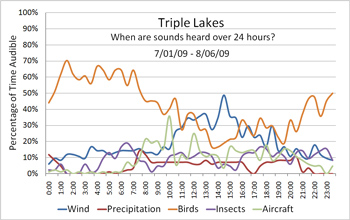
NPS photo
Many natural sounds can be heard in Denali National Park and Preserve, such as the howls of wolves, thunder of avalanches, roar of rivers, buzzing of mosquitoes, and raven croakings. Sometimes it is just completely silent.
In a park setting, a natural soundscape is an area in which the acoustic properties are those of the natural surroundings—without any sounds caused by humans or human technology. The natural soundscape is viewed by the National Park Service as a valuable park resource that should be managed, as other resources are, to retain natural properties.

NPS photo
Importance of natural soundscapes
Natural sounds may be valued by the park visitor, but the importance of natural sound is a matter of life and death to those animals that rely on complex communications. Intrusions of noise can prevent wildlife from hearing some natural sounds important in foraging or finding prey, avoiding predators, establishing territory, courtship, rearing young, and migration. Certain sounds can even cause physiological and/or behavioral responses that can reduce the animal’s ability to survive and reproduce.

Protecting soundscapes
Sounds of the wild, as well as sounds meaningful in historic settings, are protected in the National Park System. The Organic Act established parks “to conserve the scenery, the natural and historic objects and the wild life therein and to provide for the enjoyment of the same in such manner and by such means as will leave them unimpaired for the enjoyment of future generations...” This mission is interpreted to include protection of soundscapes, so visitors can hear sounds as park founders intended.
Inventorying Denali’s soundscape
Park managers have recognized that the soundscapes of Denali are becoming increasingly influenced by human-generated sounds. Managers want to preserve Denali’s natural soundscapes and the wilderness values and visitor experiences associated with them. To document baseline levels of motorized sound and monitor these sounds over time, a soundscape program was initiated at Denali in 2000. Microphones and data recorders “listen in” and record samples of Denali’s soundscapes.
As of 2010, automated sound stations have been placed at 52 park locations (see map above). At each location, digital recordings and sound pressure levels (how loud the sounds are) are collected continuously for a month.

In addition to sampling sites from a parkwide monitoring grid—which represent sites of different habitats, elevations, and areas of both frequent and infrequent motorized use—soundscape staff also sample a few other sites each year to document levels of humancaused noise at locations of management interest. These include popular snowmobiling areas (winter) and glacier tour landing sites (summer).
From the audio recordings for each location, researchers identify sound sources and calculate the number of times per day and the percentage of time each sound is audible. Sound levels of natural sounds are compared to those of human-generated sounds.

Triple Lakes: one site in a park-wide inventory
A soundscape station was placed at Triple Lakes—8 km (5 miles) from the park entrance—from July 1 to August 6, 2009. The acoustical data collected at this site show daily patterns of natural and human-generated sounds can be detected (upper graph at right).
At Triple Lakes, the aircraft traffic varied from about 30 to nearly 80 flights heard per day. The daily distribution of these flight sounds is contrasted with other natural sounds audible at the Triple Lakes site (see green line in upper graph). For the 1386 aircraft events recorded at Triple Lakes in 2009, the average maximum sound pressure level (loudness) was 45.1 decibels (dBA), and ranged from 20 to 75 dBA. Sixty-four percent of these flights were louder than the desired conditions set in the Backcountry Management Plan, and the number of aircraft sound events occuring at Triple Lakes is significantly greater than the target conditions for a pristine park soundscape.
How are the soundscape analyses being used?
Park managers are using the accoustical analyses from Triple Lakes and all other Denali sites to (1) determine whether the sound standards set for wilderness by the Denali’s Backcountry Management Plan are being met, and (2) to inform the Overflights Advisory Council—a federal advisory group formed to advise the NPS on mitigating the impacts from aircraft overflights at Denali, and to develop voluntary measures to achieve desired resource conditions at the park.
Last updated: July 28, 2016
